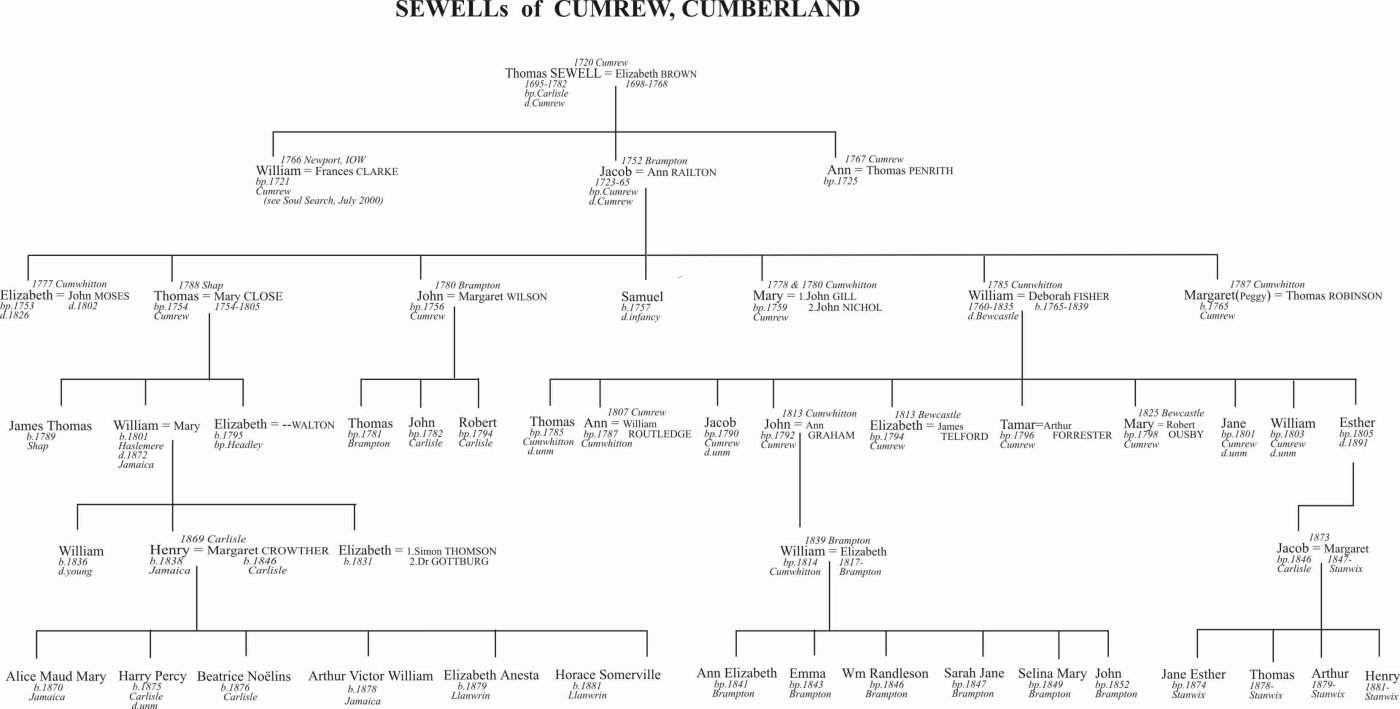

Descendants of Thomas Sewell
of Cumrew, Cumberland
By Eric Sewell
This article was originally published in the April 2001 edition of Soul Search, the journal of The Sole Society.
 Attention
has been already been drawn in Soul Search (July 2000) to M C Owen’s
genealogical study The Sewells of the Isle of Wight, published in 1906.
Tracing the family back to Thomas SEWELL of Cumrew, Mr Owen’s account dealt
mainly with the IOW branch headed by Thomas’s eldest son, the Reverend William
SEWELL. Amongst the members of this branch were a Prime Minister of New Zealand
and a vice-chancellor of Oxford University. This article concerns the
descendants of Thomas’s other son, Jacob. In this respect I am grateful for the
help of Colin Brown and Eileen Gott, both descended from the union in 1777 of
Jacob’s eldest daughter Elizabeth and John MOSES.
Attention
has been already been drawn in Soul Search (July 2000) to M C Owen’s
genealogical study The Sewells of the Isle of Wight, published in 1906.
Tracing the family back to Thomas SEWELL of Cumrew, Mr Owen’s account dealt
mainly with the IOW branch headed by Thomas’s eldest son, the Reverend William
SEWELL. Amongst the members of this branch were a Prime Minister of New Zealand
and a vice-chancellor of Oxford University. This article concerns the
descendants of Thomas’s other son, Jacob. In this respect I am grateful for the
help of Colin Brown and Eileen Gott, both descended from the union in 1777 of
Jacob’s eldest daughter Elizabeth and John MOSES.
Thomas SEWELL lived and farmed at Boonwood and later at Carlatton in the parish of Cumrew, to the south-east of Carlisle. In his will, Thomas effectively disinherited his Oxford-educated elder son, William, by bequeathing him only a shilling. The major beneficiaries were his daughter Ann and Jacob’s children, in particular William, Jacob having pre-deceased his father
William married Deborah FISHER, and having inherited the farming interests of both his father and grandfather he established himself at Sleet Beck in the border parish of Bewcastle, where he died in 1835. He had a large family, some of whom are identifiable in the 1851 Census. The eldest, Thomas, a bachelor farming 20 acres at Irthington (near Brampton), was living in 1851 with his brother Jacob and his sisters Jane and Esther. They were all unmarried although Esther had a five-year old son, Jacob. By the time of the 1881 Census, Esther was at Stanwix, Carlisle with her son Jacob, now a bank clerk and married with four children - William, Thomas, Arthur and Henry.
John was the only one of William’s sons to marry. In 1851 he was living at Brampton with his son William, a draper married to Elizabeth RANDLESON. They had five children - Ann Elizabeth, Emma, William Randleson, Sarah Jane, Selina Mary and John. Mr Owen reports that the eldest son, William R, was drowned at sea.
The children of Jacob’s second son John, who married Margaret WILSON at Brampton in 1780, have so far not been located with any certainty.
Thomas, Jacob’s eldest son, married Mary CLOSE at Shap, Westmorland in 1788. A captain in the Militia in 1796 he had moved from Shap to Haslemere (Surrey) by 1801. At Haslemere, Thomas was evidently in contact with his disinherited uncle, the Reverend William SEWELL, then rector of the nearby parish of Headley (Hants). William’s daughter Elizabeth was baptised at Headley in 1831. Thomas died in Jamaica in 1872, where William had apparently become a sugar planter. From information found on an internet site (www. jamaicanfamilysearch.com) it seems that Robert MOSES, a cousin, stayed with William, an overseer of the Alexandria sugar plantation, St Ann, Jamaica, at a date before 1824.
One can only assume that the SEWELLs prospered in Jamaica but retained their links with Cumberland. In the 1851 we find William’s second son Henry, born in Jamaica in 1838, as a pupil at Green Row Academy, Holm Cultram, Cumberland. At Green Row, Henry SEWELL would have come under the influence of Joseph SAUL, the Quaker founder of the Academy. Henry married Margaret CROWTHER in 1869 at Carlisle and had six children, all of whom appear in the 1881 Census, but in widely separated households.
Beatrice and Arthur were at Harraby Mill, Cumberland, the home of their grandmother Jane WILSON. The other four children, Alice, Percy, Nesta and Horace were at Llanwrin, Montgomeryshire with their mother, described in the Census return as the ‘wife of a West Indies sugar planter’. Llwyngwern, the house where they lived in the Dovey valley, was staffed by eight servants and a governess. Also at Llwyngwern was Henry’s sister, Elizabeth THOMSON, also a sugar planter’s wife.
Sometime after 1881 the family moved to Steephill Castle, Ventnor, Isle of Wight, a crenellated mansion built in the 1830s and demolished in the 1960s. It is interesting to note that before their arrival at Steephill Castle, because of its proximity to Osborne House, both Empress Elizabeth of Austria (1874) and Empress Eugénie (1877) had used it as a temporary residence. Of Henry’s children, Arthur became a veterinary surgeon, and Horace a Brigadier-General (see SEWELL of Tysoe Manor, Warwickshire in Burke‘s Landed Gentry for further details).
It was not until 1834 that slavery was abolished in Jamaica. One can only conclude that some of the slaves adopted the name of the plantation owner. Evidence for this is found in the island’s Manumission Records of 1821-24 (stipulating the price paid for a slave’s redemption) where some slaves are named John, Robert, Charles and Nelly SEWELL.

Return to The Sole Society Home Page